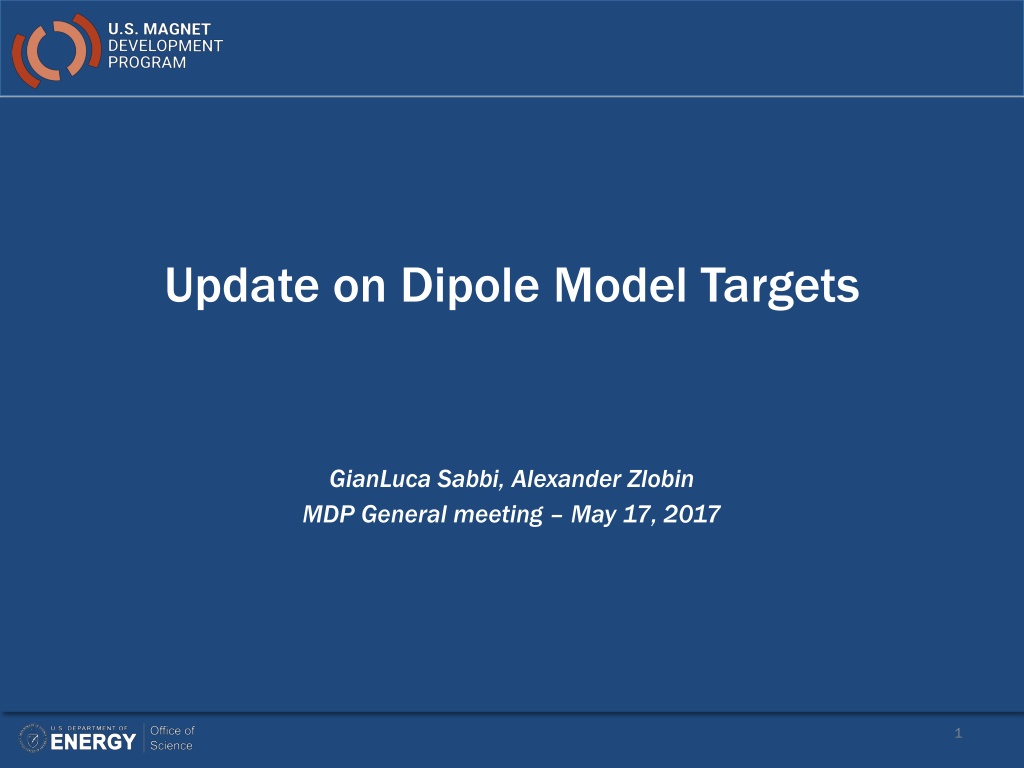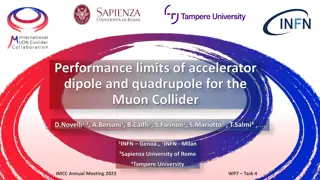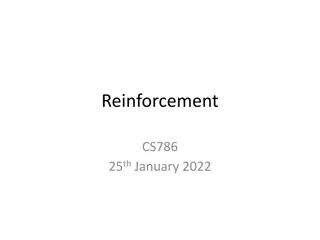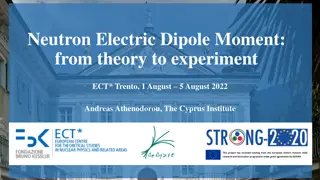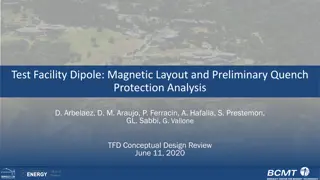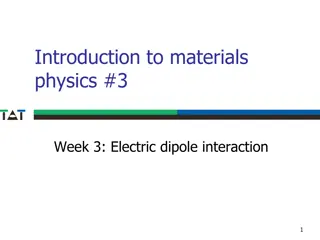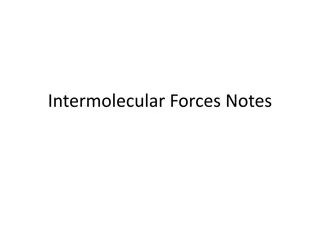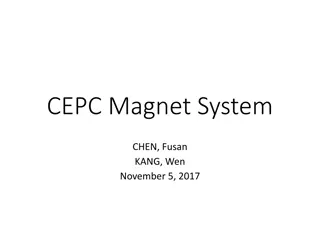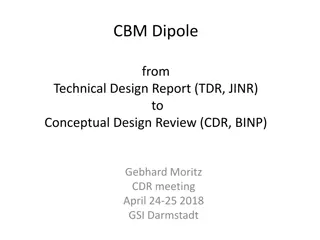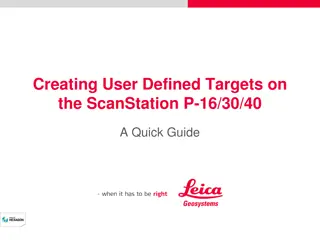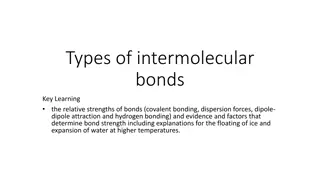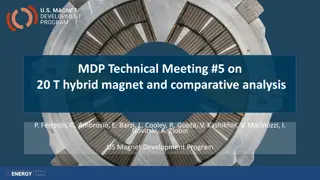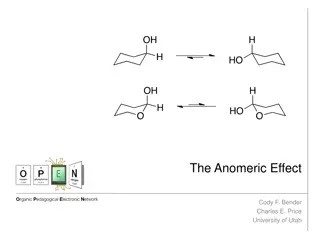Update on Dipole Model Targets for MDP General Meeting May 17, 2017
The update covers the targets and specifications for the MDP 16 T Dipole model discussed during the general meeting on May 17, 2017. It includes details such as magnet dimensions, conductor specifications, operational parameters, geometrical field harmonics, coil stress, and more. The objectives and timeline outline the purpose of the target parameters for the upcoming dipole model in the technology development program. Flexibility in R&D objectives allows for a focused proposal on specific targets.
Uploaded on Sep 21, 2024 | 0 Views
Download Presentation

Please find below an Image/Link to download the presentation.
The content on the website is provided AS IS for your information and personal use only. It may not be sold, licensed, or shared on other websites without obtaining consent from the author. Download presentation by click this link. If you encounter any issues during the download, it is possible that the publisher has removed the file from their server.
E N D
Presentation Transcript
Update on Dipole Model Targets GianLuca Sabbi, Alexander Zlobin MDP General meeting May 17, 2017 1
MDP 16 T Dipole Targets V4 MDP 16 T Dipole Targets V4 https://conferences.lbl.gov/event/82/ March 23, 2017 v.4 MDP 16 T dipole: Target parameters and specifications 1.Geometrical Magnet total length Magnet straight section Free coil aperture Maximum magnet OD (reference number) ..914 mm (LBNL/4.5K) 2.Conductor Strand diameter Cu:nonCu ratio Non Cu Jc(16T,4.2 K) RRR Reference Jc(B,T) fit Ic degradation due to cabling Maximum number of strands in cable 3.Operational Reference temperature Nominal operation field Margin on the load-line @ 1.9K Geometrical field harmonics at Rref=17 mm Target design field Maximum coil stress Maximum coil-pole separation @ 17 T <2 m >200 mm 50 mm 620 mm (FNAL/1.9K), 660 mm (BNL/1.9K), 0.7-1.2 mm 1.0 0.1 1300 A/mm2 >60 see below 5% 42 (FNAL), 60 (LBNL) 1.9 K 16 T 10 % with respect to cable Ic bn<3 for n<10 (magnet straight section) 17 T 180 MPa (150 MPa during assembly) <10 m for cable width <50% 2
1.Geometrical Magnet total length Magnet straight section Free coil aperture Maximum magnet OD (reference number) ..914 mm (LBNL/4.5K) 2.Conductor Strand diameter Cu:nonCu ratio Non Cu Jc(16T,4.2 K) RRR Reference Jc(B,T) fit Ic degradation due to cabling Maximum number of strands in cable 3.Operational Reference temperature Nominal operation field Margin on the load-line @ 1.9K Geometrical field harmonics at Rref=17 mm Target design field Maximum coil stress <2 m >200 mm 50 mm 620 mm (FNAL/1.9K), 660 mm (BNL/1.9K), 0.7-1.2 mm 1.0 0.1 1300 A/mm2 >60 see below 5% 42 (FNAL), 60 (LBNL) 1.9 K 16 T 10 % with respect to cable Ic bn<3 for n<10 (magnet straight section) Dipole Targets V4 (cont.) Dipole Targets V4 (cont.) 17 T 180 MPa (150 MPa during assembly) Maximum coil-pole separation @ 17 T 4.Quench protection Maximum hot spot temperature Total time delay Maximum voltage to ground @ quench Ground insulation design voltage 5.Reference Jc(B,T) fit: ?c2 ? = ?c201 ?1.52, ?c=?(?) where ?=?/?c0; ?=?p/?c2 (?), Bp is the conductor peak field, Tc0= 16 K, Bc20 =29.4 T, C0= 270 T.kA/mm2. 6.Each magnet concept should provide Description of magnet design including o Strand, cable and insulation (before and after reaction) o Coil cross-section (number of layers, number of turns, conductor weight/m/aperture) o Coil end design concept o Magnet support structure including transverse and axial support o Quench protection system in the case of no energy extraction Maximum magnet bore field Bmax at conductor SSL for 1.9 K and 4.5 K Dependence of Bmax on conductor Jc(16T,4.2K) Calculated geometrical field harmonics, coil magnetization and iron saturation effects in magnet straight section at Rref=17 mm for B=1-16 T Stress distribution in coil and structure at room and operation temperatures and at the nominal (16 T) and design (17 T) fields Coil-pole interface (gap) at the nominal (16 T) and design (17 T) fields Coil maximum temperature and coil-to-ground voltage during quench w/o energy extraction Cost reduction opportunities <10 m for cable width <50% https://conferences.lbl.gov/event/82/ 350 K 40 ms 1.0 kV >5 kV ?p?0.5(1 ?)2, ? ? = ?0(1 ?1.52)0.96(1 ?2)0.96 3
Objectives and Timeline Objectives and Timeline Purpose: the list of target parameters has been formulated for the next MDP dipole model which will be fabricated and tested after the 15 T dipole demonstrator being developed at FNAL and the CCT program at LBNL. Comments for discussion and clarification: MDP is primarily a technology development program. As such, there is flexibility in choosing the R&D objectives at each step. Therefore, A specific proposal may focus on a subset of the targets (this should be clarified and explained as part of the proposal) The targets are not intended as a specification for the high field accelerator dipole, although they need to be closely connected to the requirements and priorities of the ultimate application Timeline: Model fabrication in FY19+ per MDP plan. Engineering design and initial procurement FY18+ Design studies and selection FY17+. 4
How to structure the targets How to structure the targets For each area (mechanical, field quality, protection etc.) there are significant complexities which are difficult to reduce to a single number There is also some mixing between core R&D objectives and practical (not fundamental) constraints related to current component availability or existing infrastructure It might be useful to separate in different sections Keep simple/direct criteria when possible (e.g. target field) More complex topics can be described as optimization goals (e.g. hot spot temperature: design goals vs. failure case limits) Practical constraints may be grouped separately and their relevance should be discussed on a case-by-case basis (e.g. number of strands in cable, cold mass diameter, total length of coil or structure) In some cases, more detailed definitions need to be included to correctly interpret the numbers provided (e.g. length of straight section) 5
Magnet Straight Section Magnet Straight Section If the study of field quality is included in the main goals, a uniform field region of 50-100 cm ( magnet straight section ) should be provided From other programs, we have evidence of significant variations in as-built harmonics over several 10s of cm. Therefore a shorter magnet section would not provide a sufficient basis to assess field quality. Also once a short uniform field region is provided, it can generally be increased at a marginal cost in terms of total length A clear definition of the uniform region or straight section for the purpose of field quality studies should be provided Proposal: define the straight section based on design harmonics (from 3D model) being within a small delta (e.g. <0.1 units) relative to the central ones. A criterion on the transfer function may also be added, again based on the 3D magnetic model calculation (e.g. <0.05% from central) 6
Conductor Parameters Conductor Parameters Some of the values listed seem too restrictive - even for a near term procurement, there is some flexibility in the choice of the conductor layout and parameters like non-Cu fraction, etc. Is the goal to normalize different designs to the same conductor properties, for example in terms of meeting the 16 T target? Would it be better to allow for some ranges, compatible with available products, so that the design can be optimized to meet specific goals? Some examples: Copper fraction is one of the key parameters for quench protection, a given design may need more Cu to meet protection requirements Cable degradation is largely dependent on cable design but in many cases we have been able to keep it at the level of 1-2% RRR is driven by fabrication rather than design, and target should be >>60. Suggesting to include RRR as an optimization goal, aiming to avoid degradation during the fabrication process 7
Infrastructure constraints Infrastructure constraints Examples: Number of strands in cable (cabling machine) Coil length (coil winding, curing, reaction, potting infrastructure) Cold mass diameter and length (test dewar) These constraints are different in nature with respect to the R&D goals Practical implications potentially affecting the fabrication plan In some cases workarounds may be possible to limit additional costs or longer schedule Suggestion: list practical constraints at each facility in a separate section, and request that proposals include a fabrication and test plan (and possible alternatives) compatible with existing infrastructure, both in terms of physical constraints and schedule/resource availability There is also a cost element to be considered, which drives toward the smallest size compatible with the stated objectives. This could be listed as an optimization goal. 8
Field Quality Targets (Geometrical) Field Quality Targets (Geometrical) Design targets and as-built targets should be treated separately: For the design geometric and saturation harmonics, <1 unit @ 17 mm reference radius should be a reasonable objective for 50 mm aperture If some guidelines are formulated for the as-built harmonics, it should be done with the usual approach (average, uncertainty on the average, random) and the values adjusted depending on the specific contribution, and the harmonic order Since it is difficult to predict how a particular design will perform on as-built harmonics, without feedback from magnet fabrication and test, one could simply request to explain which steps are being taken to ensure accurate positioning through the various steps, and evaluate on a case by case basis 9
Field and Stress Field and Stress Definition of target design field (17 T): all requirements (mechanical stress, protection) should be met up to 17 T. Is this too ambitious? Should it be treated as an optimization goal? On the other hand if all design requirements are to be met up to 17 T, what is the role of the 16 T target? Mechanical stress: there are different implications of having high stress during pre-load (warm, cold), excitation, and in high field vs. low field areas. There are also different criteria and implications for reversible vs. permanent degradation. Different designs will be affected in different ways by these effects, and the practical limits on the stress uniformity that can be achieved in construction also play a role. Due to these complexities, it might be easier to request that a stress analysis is included as part of the design and evaluated on a case by case basis ANSYS interface conditions, bonding vs, no bonding also a complex topic, again may evaluate different options on a case-by-case basis 10
Quench Protection Quench Protection Hot spot temperature: 350 K may be acceptable as a limit, but in most cases we should aim at 250-300 K and perhaps reserve 350 K as a worst/failure case scenario The request to show that the magnet can be protected without extraction is appropriate if the study of quench protection in the accelerator is one of the goals of the model. For a technology test, one could define a different set of assumptions and criteria aiming at ensuring a safe and efficient test (e.g. taking advantage of the energy extraction to the extent possible) Delays (total and individual contributions) and maximum voltages: this again is a complex topic, depending on the protection scheme used different limits may apply. Again, might be better to request that a protection analysis is provided, and evaluate on a case by case basis 11
